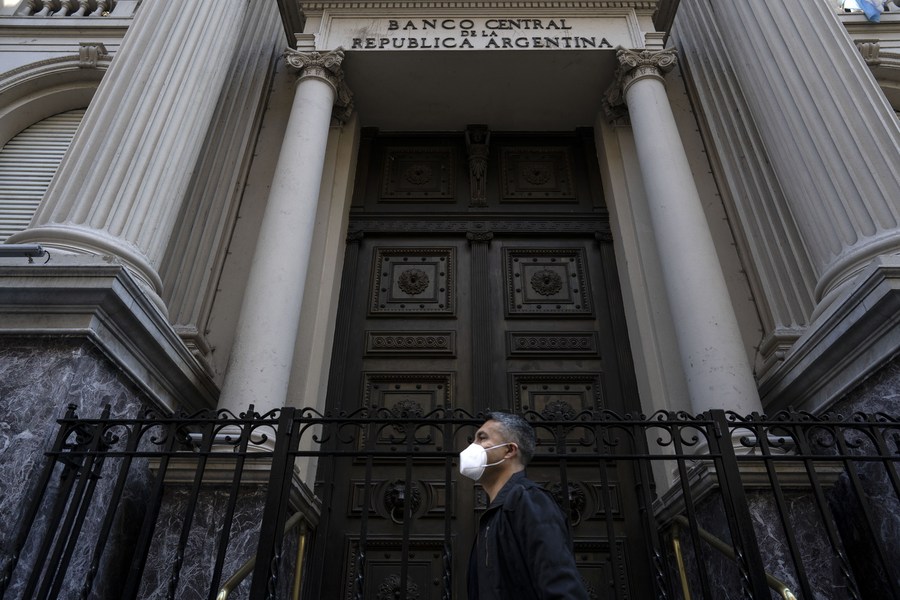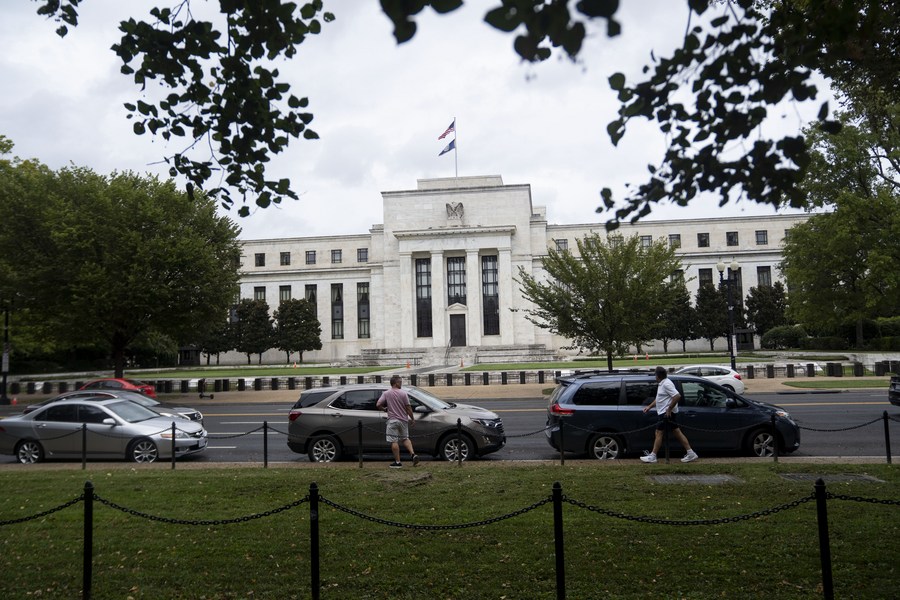Why the United States is the world's debt trap superpower
-- In 2020, global debt has seen the largest one-year surge since World War II, rising to 226 trillion U.S. dollars amid the rampage of COVID-19 and a deep recession.
-- For decades, the U.S. Fed has considerably increased the supply of dollars in the world, which causes domestic inflation and has consequences in developing countries dependent on or heavily tied-up to the U.S. economy.
-- Given the U.S. dollar's dominance in the current international monetary system and its pricing power, any big move by the Fed can obviously impact the debt construction or financial stability of other countries, especially emerging economies.
BEIJING, Jan. 21 (Xinhua) -- To mitigate rising inflation in the United States, Federal Reserve Governor Christopher Waller recently said the U.S. central bank would have to raise interest rates up "more aggressively," expecting "four, maybe five hikes" this year.

A customer shops at a Target store in New York, the United States, Dec. 10, 2021. (Xinhua/Wang Ying)
Given the U.S. dollar's dominance in the current international monetary system and its pricing power, any big move by the Fed can obviously impact the debt construction or financial stability of other countries, especially emerging economies.
History has shown that debt crises in developing countries have been causally related to the fluctuation of dollar, and America has usually come out of the crises with little loss or even a gain while the solvency of developing countries is severely undermined.
China is routinely accused by the United States and Western media of creating a financial stranglehold on other countries. These bizarre allegations have never held any merit. But there is one country that has led several nations into a suffocating debt trap, and that is the United States.
DEBT CRISES HAVE HISTORY
According to the World Bank's Global Waves of Debt report in 2019, developing countries and emerging economies have experienced four waves of debt accumulation over the past 50 years. The first wave spanned the 1970s and 1980s as Latin American countries borrowed heavily from commercial banks in syndicated loan markets, collateralized with U.S. Treasury securities.
In 2020, global debt has seen the largest one-year surge since World War II, rising to 226 trillion U.S. dollars amid the rampage of COVID-19 and a deep recession. The debt dilemma of some African and Latin American countries was once again in the spotlight.
Take Argentina for example. The country is now bargaining with the International Monetary Fund (IMF) for its 22nd loan from the Washington D.C.-based organization in seven decades. Once an agreement is signed, expect the debt of South America's second-largest economy to pile up, adding to its existing 2.8-billion-USD debt to the IMF due in late March.

A man passes by the Central Bank of Argentina in Buenos Aires, Argentina, Aug. 4, 2020. (Photo by Martin Zabala/Xinhua)
Until 2020, Latin America had become the region with the highest debt ratio in the world, Zhou Yuyuan, a senior research fellow with Shanghai Institutes for International Studies, told Xinhua in a written interview.
The nosebleed amount of foreign debt of these countries mainly comes from the international financial markets with Wall Street and Western commercial banks as main players, Zhou said.
Similar cases have emerged in Africa, Zhou added, noting that the amount of money borrowed from the private financial sector has risen rapidly, becoming the largest source of external debt.
Flush with cheap money, and saturated domestic markets, U.S. commercial banks had good pickings when they lent to developing countries, said John Pang, a senior fellow with Bard College in New York.
DOLLAR'S RIPPLE EFFECT
For decades, the U.S. Fed has considerably increased the supply of dollars in the world, which causes domestic inflation and has consequences in developing countries dependent on or heavily tied-up to the U.S. economy, said Anna Malindog-Uy, professor and researcher with Manila-based think tank Philippines-BRICS Strategic Studies.
The situation may cause hyperinflation in the developing world, she added, giving the example of how bubbles spilled over to Egypt and other Middle Eastern countries in 2008 due to their reliance on imports, which caused staggering staple food prices.

Photo taken on Sept. 22, 2021 shows the U.S. Federal Reserve in Washington, D.C., the United States. (Xinhua/Liu Jie)
The Fed policy to raise interest rates may put an early end to inflation but its negative effects would risk bursting the bubbles, noted Desmond Lachman, a senior fellow with the American Enterprise Institute.
Today's credit-markets "have been premised on the assumption that ultra-low interest rates will last forever," he said, adding that when the bubbles burst, "emerging-market economies must brace themselves for large-scale capital repatriation that could precipitate a wave of emerging-market debt crises."
Analysts point out that the Fed tightening too quickly will affect developing countries' debt problem in four ways.
First, it will trigger a rise in the value of dollar, raising the cost to pay back dollar-priced debt. Second, it will drive up global financing costs, making borrowing more expensive. Third, it will discourage funds from flowing to developing countries and decrease their sources of borrowing. Fourth, commodity prices fixed to the dollar could fall, resulting in reduced income for developing countries that rely on resource exports, and thus undermining their payback ability.
U.S. POLICY BEHIND INT'L ORGANIZATIONS
In his bestseller Confessions of an Economic Hit Man, John Perkins detailed how he was employed by a U.S. company to lobby other nations into accepting substantial infrastructure loans. "For them, this is a war about the survival of their children and cultures," he said, "while for us it is about power, money, and natural resources."

A trader works at the trading floor in the New York Stock Exchange in New York, the United States, Sept. 20, 2021. (Xinhua)
Argentina remains one of the IMF's biggest debtors today. In Argentina's debt negotiations with a series of creditors, the United States has been the real antagonist, whose purpose is to strengthen control of regional countries and maintain U.S. hegemony in transnational financial capital, said Argentine sociologist Marcelo Rodriguez in an interview with Xinhua.
Dawie Roodt, a senior economist at Efficient Group, told Xinhua that the United States is by far the biggest or the most represented country at the IMF, and it can not only block loans to some countries but also exclude countries from the banking system.
"It's a political game," he said, noting that when a country borrows money from institutions like the IMF, the funds often flow to the United States.
When asked about the role of the United States in dealing with global debt issues through multilateral mechanisms like the IMF, Pang commented, "they are 'multilateral' while being U.S.-controlled, never departing from the requirement of Western supremacy."
The policies of the IMF and World Bank promote export-oriented strategies that lead to a dependency on Western markets, Pang said.
Their assistance "would be conditional on the debtor country adopting austerity policies that squeezed the poor, enabled capital flight, and handed over economic sovereignty," he added.
(Xinhua writers Liu Kai, Yan Jie, Jin Jing, Liu Yanan, Gao Pan, Ni Ruijie and Kang Yi also contributed to the story.)
Photos
Related Stories
- Commentary: Faltering U.S. Capitol, decaying American-style democracy
- U.S. Democrats suffer defeat in election reform as bid to change Senate rules fails
- U.S. politicians' decoupling from China rhetoric "ignorant" and "arrogant," say experts
- Indicators show U.S. on brink of conflict, says Yale historian
- U.S. growth outlook in first quarter down to 3 pct amid inflation, Omicron concerns: WSJ
Copyright © 2022 People's Daily Online. All Rights Reserved.










